
Happy parrots: Those who live with parrots are increasingly being watched and even attacked by animal rights movements, especially in Europe and California. Although aviculturists receive the vast majority of criticism, bird owners also sometimes have to defend themselves over the fact that they keep feathered companions in captivity.
Sometimes bird owners disagree about how to care for their pets. Some favor feather trimming while others oppose it, and some are offended that a cage liner isn’t replaced daily, and fruits and vegetables aren’t served daily. Receiving a lot of blame like these can end up causing bird owners to feel guilty or feel the need to defend their actions.
This feeling of guilt unfortunately risks having terrible repercussions on the relationship between the parrot and the human, the latter being able to even go so far as to abandon his bird.
Healthy Signs of an African Grey Parrot

The word “happiness” is somewhat anthropomorphic, since it only applies to human behavior.
The parrot is perfectly capable of communicating their joy and well-being. If a parrot does not demonstrate the typical behaviors of a bird in health or social adjustment, it is said to be “unhappy”, and if it is unhappy, finding another home may be a good solution. Keeping a bird in captivity, however, is not rocket science.
Despite what you may hear or read, caring for a bird is not difficult. A bird’s behavior can not only indicate when something is wrong, but also whether it is happy, even if the technique used is not considered a perfect breeding technique. So, if you are worried about your bird, observe its behavior to find out if it is healthy and happy.
Although most parrots that adapt well to their environment demonstrate some or many of the following behaviors, not all birds do.
Happy Bird

Vocalization
A frustrated bird may scream while an unhappy or sick bird will not make a sound. The majority of sounds produced by birds, whether they sing, talk or chatter unintelligibly, are synonymous with well-being, which we associate with the feeling of happiness.
Preening feathers
A healthy parrot takes care of its feathers. If a bird does virtually nothing except preen its feathers, then it may be bored or have independence issues.
Bathing
Most parrots enjoy bathing in a bowl, although many like to bathe daily. A bird that does not occasionally dip its head in a bowl of clean water may not be on its plate.
Stretching
A happy and contented parrot stretches in many different ways. The bird may shrug both shoulders at the same time, stretch the wing and leg on one side in unison, then do the same with the wing and leg on the other side.
Wing flapping
Many pet birds like to hold firmly to their cage or perch and then flap their wings. If your bird flaps its wings, it’s not because it’s unhappy.
Tail Wagging
When a healthy, happy parrot intends to change its activity, it will sometimes wag its tail energetically. This behavior resembles human clucking and can occur after an unpleasant activity, such as a fall from a perch or a toy during play. It indicates that the bird is ready to move on to another activity.
Beak Grinding
A sleepy parrot that serves its maxilla and mandible together in a squealing manner with its eyes closed shows that it is satisfied; he acts this way for his comfort. This behavior does not lead to any disastrous consequences in parrots, and may or may not have repercussions on the beak.
Ruffled Feathers
If a bird has ruffled feathers, but is not in a drafty area and does not appear to be showing signs of disease, it shows his well-being, his interest, or his happiness. This behavior is often accompanied by a tail wag or even a brief whole-body tremor. A sick bird with ruffled feathers usually stands on two legs and shows other signs of discomfort.
Only one leg on the perch
A bird in poor health sometimes needs to hold on to the perch with both legs. A healthy, well-balanced bird, on the other hand, usually sleeps with one leg raised and placed under its belly feathers. This paw then gets rather warm, and that’s completely normal.
Fun with toys
In adulthood, parrots are not the only ones who still have fun, even if very few adult animals use toys for fun.
Tongue wiggle or tactile use of the tongue
A bird may wiggle its tongue because it craves petting. The tongue is a sensory organ in the parrot, so if he accepts being stroked, it is usually because he is happy to interact with this person. However, even a sick bird can have its tongue stroked by a human when it comes to its favorite person.
Beak rubbing
A parrot usually rubs its beak on a perch or cage accessory because it wants to remove food residue stuck to its beak, but it also happens that it rubs its beak on a perch or person because he is happy, quite simply.
Narrowing Pupil
A healthy parrot pupil shrinking, causing the iris to enlarge, indicates that it is interested in or stimulated by something. This shrinkage demonstrates motivation to speak or sing on the part of the bird. Like paw stamping, this behavior can be accompanied by territorial aggression.
Dancing or Head-Shaking
A parrot dancing and moving its head usually indicates that it is fit and feeling good. Head movements can also lead to courtship behavior or sexual behavior.
Body inclination or solicitation
A parrot leaning towards something or someone expresses a desire towards that object or person. If the bird is used to flying, this behavior may mean that it is about to take flight.
Flying or stalking
If your bird follows you everywhere in the house by flying or walking, it is that he is very happy in your company or that he is stalking you; somehow he is healthy and confident.
Beak snapping
When a cockatoo and other parrot species wiggle their tongues, it often happens that their jaws move rapidly up and down at the same time. This behavior expresses joy, although some mischievous birds do so in order to get petted and then bite the person just for fun.
Leg or beak tapping
Leg or beak tapping against a perch, wall, toy or human is a territorial behavior that can be accompanied by aggressive behavior in adult birds. It also indicates a sense of well-being in these creatures which, it must not be forgotten, always remain partly wild.
Sexual Motivation
Although biting and territorial behavior may accompany sexual displays such as masturbation, these behaviors usually indicate that the bird is happy and healthy.
A sick or maladjusted bird exhibits few, if any, of the above behaviors. If you are concerned about your bird’s health because he is not expressing his well-being, take him to an avian veterinarian immediately.
If after a medical examination the bird is considered healthy, check and enrich its physical and social environment. Birds are joy incarnate. The happiness of these feathered animals is contagious, and sharing it with them is the essence of life for those of us who are lucky enough to be in their company.




















